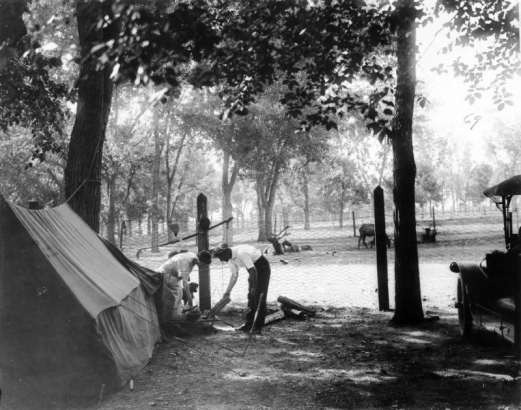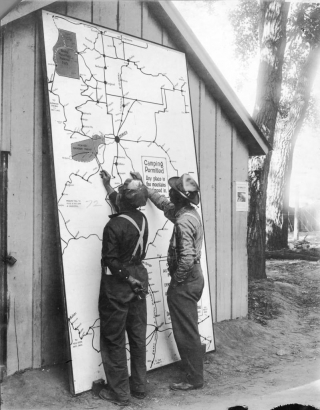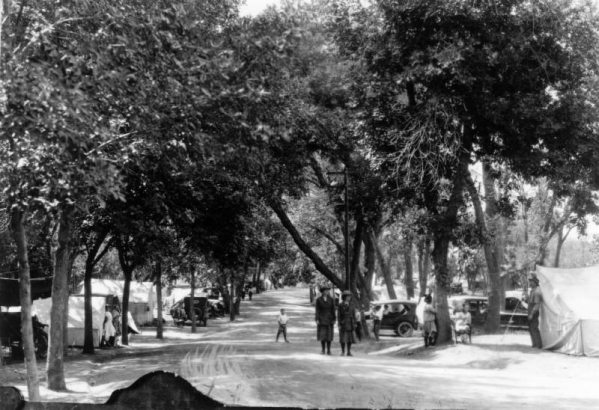Imagine a free campground in the middle of a city park, open to tourists and residents alike, with no permit required. How popular would that be? How would that change our relationship with the park itself? There was once a time when urban camping (though not as we know it) was widespread and even encouraged in numerous Denver parks, including Denver’s main City Park. One hundred years ago, the advent of the automobile changed American vacations drastically, and Denver jumped at the opportunity to bring and keep these new tourists in town.
Beginning in 1914, the Denver Parks department began allowing travelers to stop in City Park as a campground. According to the August 22, 1914, issue of Denver Municipal Facts,
“any one wishing to use City Park for a camping ground, need only to see an employe [sic] of the park and they will gladly direct them to the proper place, as there is no need of first securing a permit from the department.”
Campers could appreciate amenities such as playgrounds and “up-to-date sanitary conditions,” and all that they had to do in return was douse their fires and clean up their trash.
By 1916, City Park’s motor camp was booming so much that there were concerns that the grounds and facilities would not be enough. More than 5,000 campers (in nearly 2,000 vehicles) streamed in from as far afield as Massachusetts; there was even one visitor from the Philippine Islands. Use in 1916 was so high that an appeal was made in the Denver Post and Parks officials responded by expanding the public camping ground midseason. Even more land was expected to be dedicated to car campers the following year.
The trend indeed only expanded from there. The April 1918 Municipal Facts quoted the Parks annual report for 1917, in which Assistant Director of National Parks Horace M. Allbright stated,
“It is an inspiring sight to go into a park like the beautiful City Park of Denver and see several hundred cars parked in their allotted spaces and their happy owners, many of them with large families, enjoying the camp life or recreational facilities of their surroundings….The few days spent in the free public automobile camp of a big city park were giving hundreds of families from farms and small towns the opportunity to enjoy its advantages for the first time.”
Authorities used the lessons that they had learned at City Park as the system of motor parks expanded into the next decades. In 1918, they opened Rocky Mountain Lake Park, which would provide 236 camping lots (compared to 167 at City Park) as use had dramatically increased as the years passed. Additionally, wood was now sold for five cents, in the interest of preventing overconsumption of the limited supply. Services also increased, including “electric lights, hydrant water, free mail delivery, free fire brick for outdoor ovens, daily camp clean-ups and sprinkling of the streets to keep down the dust.” Additional parks were Berkeley Park, with a bathing beach and golf course, and Genesee Park, a true mountain park located 20 miles away.
By the 1920s, most of the focus had moved to other motor camps, most notably Overland Park, which hosted more than 11,000 cars in 1921. It’s incredible to see how, even as the advent of motor vehicles spelled danger for the environment, it also changed our connection to it. Would Denver’s network of parks be the same without this history of camping in the city? With numerous urban parks and nearly 20,000 acres of parkland available today, we are ever more thankful for these oases of greenery in a city that continues to expand and urbanize.




Comments
nise
nise
Add new comment